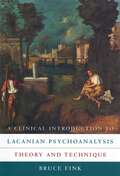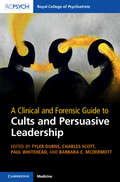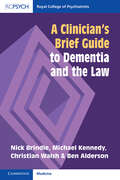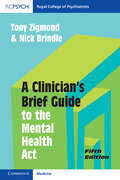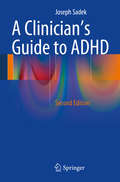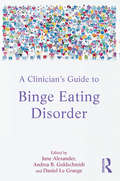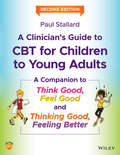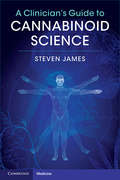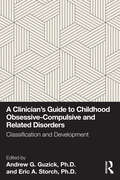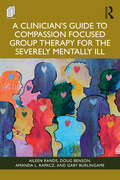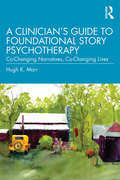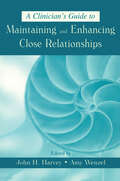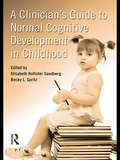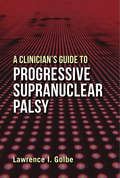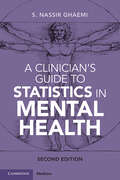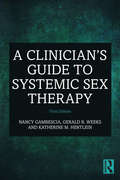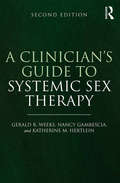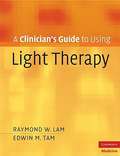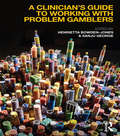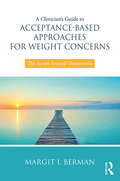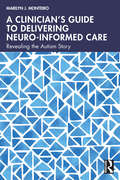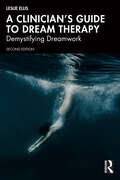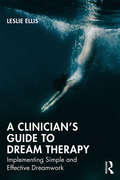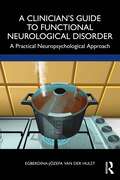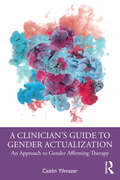- Table View
- List View
A Clinical Introduction to Lacanian Psychoanalysis: Theory and Technique
by Bruce FinkArguably the most profound psychoanalytic thinker since Freud, and deeply influential in many fields, Jacques Lacan often seems opaque to those he most wanted to reach. These are the readers Bruce Fink addresses in this clear and practical account of Lacan's highly original approach to therapy. Written by a clinician for clinicians, Fink's introduction is an invaluable guide to Lacanian psychoanalysis, how it's done, and how it differs from other forms of therapy. While elucidating many of Lacan's theoretical notions, the book does so from the perspective of the practitioner faced with the pressing questions of diagnosis, which therapeutic stance to adopt, how to involve the patient, and how to bring about change.
A Clinical and Forensic Guide to Cults and Persuasive Leadership
by Charles Scott Paul Whitehead Tyler Durns Barbara McDermottCults have captivated public imagination, gained visibility in the media, and become a popular topic of discourse. While anecdotal and journalistic accounts offer compelling insights, systematic study on the structure, psychological predispositions, and relevance to clinical and legal settings are comparatively scarce. This disparity highlights a crucial need for rigorous scholarly inquiry, moving beyond media portrayals to uncover the foundational mechanisms that sustain and shape these enigmatic groups. Authored by experts in forensic psychiatry and psychology, this book consolidates the extant literature in reviewing the theoretical, sociocultural, clinical, and forensic issues surrounding cultist groups. This text applies evidence-based study to identify group subtypes and explore mediators and moderators that may be relevant in clinical and legal contexts. Authors address issues as they relate to a variety of subpopulations, comorbid mental disorders, mind-altering substances, treatment, and the and legal implications inherent to cults and persuasive leadership. This book may be especially pertinent to mental health professionals and those working in the criminal justice system.
A Clinician's Brief Guide to Dementia and the Law
by Michael Kennedy Nick Brindle Christian Walsh Ben AldersonDementia is a topic of enormous medical, legal and ethical importance with considerable human and economic cost. Its importance grows with the change in demographics of the aging population and that people with dementia receive care in a wide range of settings. The legal and ethical problems raised in treating patients with dementia are diverse and complex and are dealt with by many practitioners on a daily basis. This book is a 'how-to' guide to understanding how the law applies to people with dementia, from diagnosis through to end-of-life. It explores the practical problems that people experience, and practitioners face, giving an accurate account of statute, court cases and other inquiries, to give readers an up-to-date account of the law and how it applies in this area. An essential read for clinicians and practitioners that work with patients with dementia, including psychiatrists, primary care physicians, nurses, social workers and advocates.
A Clinician's Brief Guide to the Mental Health Act (A Clinician's Brief Guide)
by Tony Zigmond Nick BrindleA 'how to' book guiding clinicians through the mental health legislation that they need to understand and use in their daily practice, covering the Mental Health Act 1983 and subsequent amendments. This revised and updated edition incorporates new acts, such as the Policing and Crime Act 2017 and Mental Capacity (Amendment) Act 2019. It also covers the findings and implications from Professor Sir Simon Wessely's 2018 review of the Mental Health Act in a new chapter. Written by two leading psychiatrists with many years of experience in using the mental health legislation and in running mental health law courses, this book outlines how changes to statutes and case law have a direct bearing on day-to-day psychiatric practice and why it is important that clinicians of all disciplines have access to and understand the legislation. This is the go-to guide for all clinicians, doctors and nurses working in mental health services.
A Clinician's Guide to ADHD
by Joseph SadekThe Clinician's Guide to ADHD combines the useful diagnostic and treatment approaches advocated in different guidelines with insights from other sources, including recent literature reviews and web resources. The aim is to provide clinicians with clear, concise, and reliable advice on how to approach this complex disorder. The guidelines referred to in compiling the book derive from authoritative sources in different regions of the world, including the United States, Canada, Australia, and Europe. After introductory discussion of epidemiology and etiology, guidance is provided on diagnosis in different age groups, differential diagnosis, assessment for potential comorbidities, and the issue of ADHD and driving. Advice is then given on the appropriate use of pharmacological and psychosocial treatment, the management of adverse events, and follow-up. A series of relevant scales, questionnaires, and websites are also included.
A Clinician's Guide to Binge Eating Disorder
by Daniel Le Grange June Alexander Andrea B. GoldschmidtIncidence of BED appears to be on the increase. Treating it, and overcoming it, is all the more difficult, especially for those living in a culture that has an intense body image focus. A Clinician’s Guide to Binge Eating Disorder educates the reader about its triggers and behaviours – and describes steps to treat it and resume a full and productive life. Evidence-based research outcomes provide the framework and foundation for this book. First-person case studies bring application of this science to life to help close the gap between research and treatment/care, and the importance of clinicians developing a therapeutic relationship as a healing tool with their client is discussed, recognizing that medical and psychological dimensions are inextricably intertwined. This book allays fear of the unknown, explains the emotional chaos that can sweep in like a storm when, unintentionally, triggers are released. It provides practical steps and footholds for clinicians and researchers to help the patient take control of their life and look to a positive future.
A Clinician's Guide to CBT for Children to Young Adults: A Companion to Think Good, Feel Good and Thinking Good, Feeling Better
by Paul StallardA powerful and insightful clinical resource for CBT practitioners who work with children and young adults The newly updated and thoroughly revised Second Edition of this companion to Think Good, Feel Good and Thinking Good, Feeling Better delivers guidance for clinicians using the author’s seminal workbooks. This companion work builds upon the workbook materials by offering readers instruction on all aspects of the therapeutic process and a wide range of case studies highlighting specific therapies in action. A Clinician’s Guide covers topics including parental involvement, key cognitive distortions in children, formulations, challenging thoughts, guided discovery, and the use of imagery. The author also includes a chapter focusing on common potential problems that arise in therapy and strategies to overcome them. The book highlights the underlying philosophy, process, and core skills of employing CBT with children and young people. Readers will appreciate the competency framework, which describes the CORE philosophy, PRECISE process, and the ABCs of specific techniques. The book also includes: Additional materials and handouts for use in therapy, including psycho-educational materials for children and parents on common problems, like depression, OCD, PTSD, and anxiety Downloadable, multi-use worksheets for use in the clinician’s therapeutic sessions Practical, real-world case examples that shed light on the techniques and strategies discussed in the book A systematic approach to the use of cognitive behavioural therapy to treat common psychological problems Perfect for professionals and trainees in child and adolescent mental health, like psychiatrists, clinical psychologists, educational psychologists, community psychiatric nurses, and occupational therapists, the book also belongs on the shelves of non-mental health professionals, including school nurses and social workers, who regularly work with children in a therapeutic setting.
A Clinician's Guide to Cannabinoid Science
by Steven JamesMedical marijuana and the promise of medical advances with cannabinoids is a controversial topic. This book provides clinicians with credible, peer-reviewed science to advise patients on the use of cannabinoids in practice. From the history of cannabis to the recent discoveries, chapters include the science of cannabinoids, changes in the legal and regulatory landscape, and the emerging area of endocannabinoids. The book differentiates approved cannabinoids from cannabis and medical marijuana and stimulates clinicians to think about the risks and benefits of these two drugs. It provides the factual background for clinicians to lead the discussion on the continued use of marijuana, ongoing areas of research and future advances and development of new medications for treatment. An invaluable guide for all specialists in the pharmaceutical sciences, toxicologists, biochemists, neurologists, psychiatrists, addiction specialists, as well as primary care physicians, nurse practitioners, and regulators and policymakers.
A Clinician's Guide to Childhood Obsessive-Compulsive and Related Disorders: Classification and Development
by Andrew G. GuzickThis book provides mental health clinicians and trainees with an overview of the new category of obsessive-compulsive and related disorders as they apply to youth.These disorders are highly impairing but can typically be overlooked in children and adolescents when they most often onset. This book draws attention to these disorders and provides an up-to-date review on the classification and development of these conditions in youth. Chapters explore the arguments for and against the new obsessive-compulsive related disorder DSM-5 category, provide reviews of transdiagnostic factors believed to underly these disorders, as well expert overviews of the clinical disorders that make up this category. An international team of contributors focuses on a range of topics such as: pediatric acute-onset neuropsychiatric syndrome, early-onset and tic-related OCD, common comorbid psychiatric conditions in youth, developmental neurobiology, and more.This book is an essential read for clinicians who specialize in OCD and related disorders and treat children. It is also applicable to clinicians, trainees, and students across mental health disciplines such as: psychology, psychiatry, social work, mental health, and counselling.
A Clinician's Guide to Compassion Focused Group Therapy for the Severely Mentally Ill
by Doug Benson Gary Burlingame Aileen Rands Amanda L. RapaczThis manual provides clinicians with guidance to conduct compassion focused group therapy with patients suffering from severe forms of mental illness.Historically, those suffering from severe forms of mental illness face a myriad of biological, psychological, and social challenges, particularly shame and self-criticism. Compassion focused therapy is known to combat and address this suffering. This manual connects rich biological, psychological, and social theory with empirical findings and lived clinical experience. Comprising 12 modules, this clinician’s guide presents psychoeducation in conjunction with intrapersonal/interpersonal exercises and process-oriented instructions to aid treatment and guide group therapy sessions.This book, created by clinicians for clinicians, is a vital resource for psychiatrists, psychologists, social workers, or substance use disorder counselors, offering compassion focused group therapy in an inpatient setting.
A Clinician's Guide to Foundational Story Psychotherapy: Co-Changing Narratives, Co-Changing Lives
by Hugh K. MarrA Clinician's Guide to Foundational Story Psychotherapy draws together a range of theories and models to examine the use of narrative psychotherapy in clinical practice. Illustrated with case examples and biographical vignettes, the book outlines the importance of foundational and life stories in treatment and delineates new techniques for co-assessing and changing stories. A wealth of concrete tools are included, such as the Foundational Story Interview and Family of Origin Map, as well as diagram templates and questionnaires for use during clinical sessions. Integrating theory and practical applications, A Clinician's Guide to Foundational Story Psychotherapy introduces a range of therapeutic options rooted in a narrative context and is a valuable resource for practicing and student psychotherapists.
A Clinician's Guide to Maintaining and Enhancing Close Relationships
by Amy Wenzel John H. HarveyIn the past 10 years, there has been a substantial increase in the number of theoretical and empirical investigations into the maintenance and enhancement of close, romantic relationships. This literature targets the everyday behaviors, expressions of love, and cognitive styles that characterize such relationships. Chapters provide a sampling of the expanse of topics in the domain of how clinical scholars and practitioners address the timely topic of maintaining and enhancing close romantic relationships, including marriage. A distinguished group of scholars and therapists discuss specific problems, such as alcoholism and therapeutic interventions, such as insight therapy. Topics include maintenance issues relevant to: depression, anxiety disorders, the role of children in affecting close relationships, how premarital therapy may serve as an antidote to early relationship problems, forgiveness, remarriage issues, and peer marriage. This volume is intended for practitioners in the field of close romantic relationships, such as marriage, family and relationship therapists, and clinicians.
A Clinician's Guide to Normal Cognitive Development in Childhood
by Elisabeth Hollister SandbergClinicians and practitioners-in-training can often lose sight of the normal developmental landscape that underlies behavior, especially in the field of cognitive development. It exists in an insular bubble within the broader field of psychology, and within each sub-domain there is a wide continuum between the anchors of atypical and optimal development. Clinicians need to learn, and to be reminded of, the unique peculiarities of developing cognitive skills in order to appreciate normal developmental phenomena. In A Clinician's Guide to Normal Cognitive Development in Childhood, every chapter provides students and established professionals with an accessible set of descriptions of normal childhood cognition, accompanied by suggestions for how to think about normal development in a clinical context. Each sub-topic within cognitive development is explicated through a succinct presentation of empirical data in that area, followed by a discussion of the ethical implications. With an extensive review of data and clinical practice techniques, professionals and students alike will benefit enormously from this resource.
A Clinician's Guide to Progressive Supranuclear Palsy
by Lawrence I. GolbeThis brief, clinically-focused volume is informed by Lawrence I. Golbe’s three decades of research and tertiary clinical care in progressive supranuclear palsy, a complex disorder with rapidly changing diagnostic and therapeutic approaches. It is an ideal source for the general neurologist seeking a refresher and the primary care provider, neurological nurse, or physical, occupational or speech therapist who must address their patients’ specialized needs. A Clinician’s Guide to Progressive Supranuclear Palsy emphasizes early diagnostic signs, medication options, non-pharmacologic management and palliative care. It offers a quick overview of the complications of PSP most likely to prompt an ER visit; a widening spectrum of PSP variants; and ample description of the genetics, epidemiology, natural history, pathology, molecular biology and neurochemistry of PSP. The PSP Rating Scale used in the book is a convenient tool for clinicians in routine practice and the leading PSP clinical measure world-wide. Golbe provides a practical and useful guidebook to help all clinicians learn and battle this complex disorder.
A Clinician's Guide to Statistics in Mental Health: Measuring Truth And Uncertainty
by S. Nassir GhaemiThe second edition of a clear and accessible guide to the application of statistics in psychiatric practice. The book expertly describes statistical concepts in clear and simple terms, with minimal mathematical content, making it the ideal resource for busy mental health professionals. Fully revised throughout, it features five new chapters covering key advances in the field and important topics in greater detail. Amongst the key concepts discussed in this edition are the logic of randomization, clinical trials, the overuse of p-values, understanding effect sizes, meta-analysis and why clinical experience is limited by observational confounding bias. Featuring a wealth of clinical examples, on topics of high importance or controversy in psychiatry, plus explanations and reasoning, to give clinicians a better understanding of how to apply research to their practice.
A Clinician's Guide to Systemic Sex Therapy
by Gerald R. Weeks Nancy Gambescia Katherine M. HertleinThis new edition of A Clinician's Guide to Systemic Sex Therapy integrates the latest empirical research from the field of sex therapy and demonstrates how clinicians can optimize their treatment for a wide range of clients. Grounded in the Intersystem Approach, the book incorporates the multifaceted perspectives of the individual client, couple, or family. It considers every domain of assessment and treatment: biology, psychology, the intimate relationship, family-of-origin, and larger contextual factors contributing to any sexual/relational issue. This revised edition contains 13 chapters consistent with the DSM-5 definitions of sexual disorders and features new content on areas including LGBTQ+ issues, non-monogamous relationships, intersex clients, and an increased focus on issues surrounding sexual diversity. The authors of this award-winning text have set out a cutting-edge framework for clinicians looking to develop a comprehensive understanding of sexual issues, which will be an essential reference point for beginning and seasoned therapists alike.
A Clinician's Guide to Systemic Sex Therapy
by Gerald Weeks Nancy Gambescia Katherine HertleinThe second edition of A Clinician’s Guide to Systemic Sex Therapy has been completely revised, updated, and expanded. This volume is written for beginning psychotherapy practitioners in order to guide them through the complexities of sex therapy and help them to be more efficient in their treatment. The authors offer a unique theoretical approach to understanding and treating sexual problems from a systemic perspective, incorporating the multifaceted perspectives of the individual client, the couple, the family, and the other contextual factors. Both beginning and experienced sex/relationship therapists will broaden their perspectives with the Intersystem approach and gain information rarely seen in sex therapy texts such as: how to thoroughly assess each sexual disorder, the implementation of various treatment principles and techniques, how to incorporate homework, dealing with ethical dilemmas, understanding different expressions of sexual behavior, and addressing the impact of medical problems on sexuality. Aside from bringing the diagnostic criteria up-to-date with the DSM 5, this new edition contains a new chapter on sensate focus, an expanded section on assessment, more information about development across the lifespan, and more focus on diversity issues throughout the text.
A Clinician's Guide to Using Light Therapy
by Raymond W. Lam Edwin M. TamLight therapy is an effective, evidence-based, non-pharmacological treatment for seasonal affective disorder (SAD) and other depressive and circadian sleep conditions. This step-by-step guide helps busy mental health clinicians and other health professionals to better diagnose SAD and incorporate light therapy into their everyday clinical practice. The authors summarize the diagnostic process, describe a simplified method for light therapy and provide practical information on how to evaluate and obtain light devices. Invaluable clinician resources such as educational handouts, lists of frequently asked questions, instruction sheets, rating scales and suggestions for additional sources of information are also included. Case studies are used throughout to illustrate the processes and techniques in their clinical context.
A Clinician's Guide to Working with Problem Gamblers
by Henrietta Bowden-Jones Sanju GeorgeProblem gambling is a recognised mental disorder and a significant public health issue internationally. A Clinician’s Guide to Working with Problem Gamblers introduces the reader to the concept of problem gambling as an illness, it describes the current gambling habits and explores the way problem gambling may present in an individual. This guide is the product of a collaboration between two of the country’s most eminent experts on problem gambling as a psychiatric disorder. Bowden-Jones and George bring together contributions from leading clinicians working in the field to provide an outline of the epidemiology, aetiology, research, assessment procedures and treatment practices which are discussed and presented in an accessible and engaging manner. The inclusion of questionnaires and screening tools adds to the ‘hands on’ feel of the book. The book covers a range of topics that clinicians and trainees need in order to review and understand the disorder, including, amongst others: Cognitive behavioural models of problem gambling Psychiatric co-morbidity Family interventions Gambling and women Remote gambling A Clinician’s Guide to Working with Problem Gamblers will be essential reading for mental health professionals working with problem gamblers, as well as those in training, it is a comprehensive reference point on all aspects of this psychiatric condition. It is also aimed at various other groups of people who have an interest in the field of problem gambling, including academics, researchers, policy makers, NHS commissioners, probation officers, other health care professionals, the lay reader and family members of those affected by gambling.
A Clinician’s Guide to Acceptance-Based Approaches for Weight Concerns: The Accept Yourself! Framework
by Margit BermanThis clinician manual presents the Accept Yourself! Program, which is derived from empirically supported interventions (including Acceptance and Commitment Therapy and Health At Every Size) that have a demonstrated ability to enhance women’s mental and physical health. This book offers a clear, research-based, and forgiving explanation for clients’ failure to lose weight, helpful guidance for clinicians who are frustrated with poor client weight loss outcomes, as well as a liberating invitation to clients to give up this struggle and find another way to achieve their dreams and goals.
A Clinician’s Guide to Delivering Neuro-Informed Care: Revealing the Autism Story
by Marilyn J. MonteiroThis neurodiversity-informed handbook provides clinicians with a way to think, talk, and write about the autism spectrum brain style in positive, descriptive language that is tailored to the needs of individual clients.Each chapter provides readers with compelling and instantly recognizable ways to reveal the autistic brain's strengths and differences, reframe behavioral patterns using neuro-affirming language, and link those descriptions to practical, positive supports. The book includes a glossary of descriptive terms and multiple examples of autistic Brain Style Profiles that hold the client’s lived experience at the center of treatment, while allowing for individualized treatment and support based on the client’s age and verbal fluency.This book is an ideal resource for clinicians who wish to reframe diagnosis into a strengths-based narrative and partner with clients to support self-determined needs.
A Clinician’s Guide to Dream Therapy: Demystifying Dreamwork
by Leslie EllisA Clinician’s Guide to Dream Therapy demystifies the process of working with dreams by providing both a grounding in the current science of dreaming as well as a simple, practical approach to clinical dreamwork.In addition to a survey of the current science and neuroscience of dreaming, this book includes clinical examples of specific techniques with detailed transcripts and follow-up commentary. Chapters cover how to work with PTSD nightmares and their relationship to the nervous system and polyvagal theory, and how to use experiential dreamwork techniques to produce lasting change. This second edition has been thoroughly updated throughout, including new case studies, and a new, detailed clinical example of embodied experiential dreamwork.Readers will be able to discuss their clients’ dream material with confidence, armed with an approach that helps them collaboratively tap into the inherent power for change found in every dream.
A Clinician’s Guide to Dream Therapy: Implementing Simple and Effective Dreamwork
by Leslie EllisA Clinician’s Guide to Dream Therapy demystifies the process of working with dreams by providing both a grounding in the current science of dreaming as well as a simple, practical approach to clinical dream work. In addition to a survey of the current science and neuroscience of dreaming, this book includes clinical examples of specific techniques with detailed transcripts and follow-up commentary. Chapters cover how to work with PTSD nightmares and how to use experiential dreamwork techniques drawn from current neuroscience to engender lasting change. Readers will be able to discuss their clients’ dream material with confidence, armed with an approach that helps them collaboratively tap into the inherent power for change found in every dream. Backed by research, common factors analysis and neuroscience, the approaches described in this book provide a clear map for clinicians and others interested in unlocking the healing power inherent in dreams.
A Clinician’s Guide to Functional Neurological Disorder: A Practical Neuropsychological Approach
by Egberdina-Józefa van der HulstThis manual for clinicians presents a ground-breaking, accessible and unifying new model for understanding functional neurological disorder (FND) that bridges the gap between theoretical FND-specific models and the more practical, but non-FND-specific Cognitive Behavioural Therapy (CBT) models. Grounded in psychology, the Pressure Cooker Model provides a clear metaphor for FND, focusing on intra-individual and inter-individual cognitive, emotional and behavioural processes. Developed based on years of clinical experience in the field, it is applicable to the assessment and treatment of every type of FND. Viewed as a systemic condition with unique psychosocial features, the book will describe the rationale for radically transforming FND recovery by providing a treatment model that aims to resolve emotion dysregulation processes and repair relationships between the person and the system. It uses a unifying framework to guide the steps of intervention and can be adapted for work in a multidisciplinary team context to facilitate communication between disciplines. Enriched with case studies and research data, the book also highlights a plethora of clinical tools and strategies based on the Pressure Cooker Model, as well as contextualising its position alongside CBT models. This manual is instrumental in educating and treating people with FND. It offers essential guidance for neuropsychologists, neuropsychiatrists and other health professionals, as well as students in these fields.
A Clinician’s Guide to Gender Actualization: An Approach to Gender Affirming Therapy
by Caitlin YilmazerA Clinician’s Guide to Gender Actualization provides an essential guide for mental health professionals working with gender diverse clients, delivering material that challenges clinicians to provide affirming specialized care for their clients. Gender actualization is the social, expressive, and existential process of becoming and integrating one’s authentic self through the context of gender identity, and this book introduces an effective clinical model for competent gender therapy care. Building upon the reader’s foundational knowledge, chapters provide useful assessment tools, interventions, and treatment strategies to implement in their clinical practice, with accompanying personal narratives and client experiences woven throughout. Challenging readers to explore intersectionality and the crucial awareness of their own privileges, this book is a critical read for providers working with or seeking to educate themselves regarding gender diverse clients.
